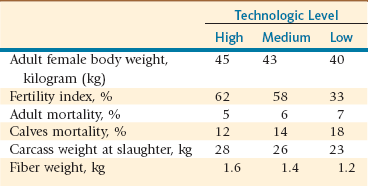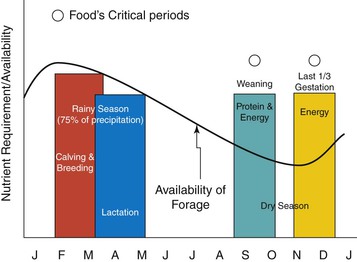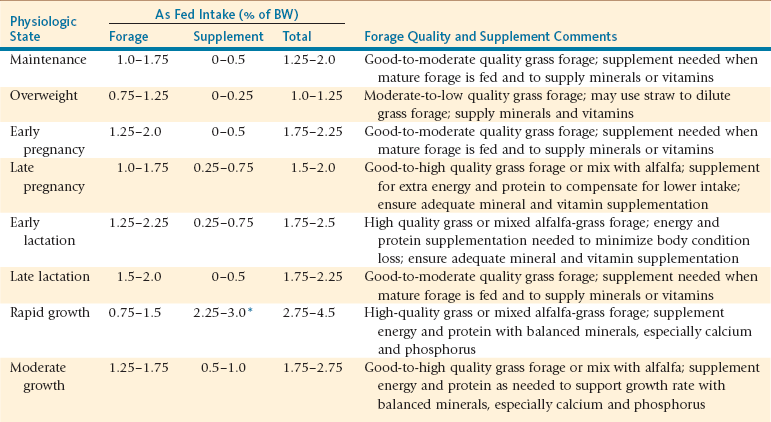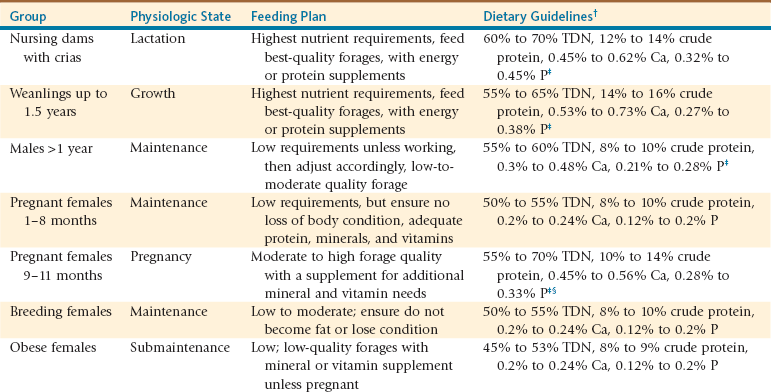Feeding Management Systems
Agroecosystems for South American Camelid Production
Population, Geographic Area of Breeding, and Farming Systems
With the exception of guanacos, whose major population is found in Argentina (more than 80%), the largest populations of llamas (96%), alpacas (99%), and vicuna (94%) are located in Peru and Bolivia. Of the world’s alpaca and vicuna population, 91% are found in Peru, and 70% of the world’s llama population is found in Bolivia.1
SACs are associated with the puna zone at altitudes between 3600 to 5000 m, with an increase in the breeding of alpacas from 4000 m and greater. In Peru, farming systems are classified according to their livestock composition: (1) farms where alpacas are handled separately from sheep and cattle; (2) farms where the alpacas and sheep are managed together; and (3) farms where alpacas, sheep, and cattle are all handled together. The first is characteristic of cooperatives, and the last two systems are more specific to communities and small and medium producers. It was observed that at altitudes above 4300 m, the species proportion on farms was 2% cattle, 30% sheep, and 61% SACs, whereas for altitudes lower than 4000 m, this proportion was 10%, 89%, and 1% for cattle, sheep, and SACs, respectively.2
The carrying capacity of the high Andean region in Peru was estimated at 30.6 million sheep units per annum. However, the current load exceeds that by more than 5 million sheep unit per year.3 Because of overgrazing at over 50% of sites located in these grasslands, grazing areas are in poor or very poor condition. Overgrazing is the result of practical difficulties of pasture management, mostly because of land tenure systems, especially in communal lands.
In Bolivia, llamas are generally associated with sheep in farming systems. Llama breeding occurs in the harshest zone of the Altiplano, where most agricultural activities are not possible. The Altiplano is characterized by an annual precipitation around 300 millimeters (mm) (11.8 inches) with tremendous interannual variation from 90 to 500 mm (3.5 to 19.7 inches). Oruro and Potosi are regions with 60% of the total llama population (1.21 million).4
Characteristics of Breeding
Bryant and colleagues evaluated the effect of technologic levels in alpaca breeding and found marked differences, especially between the high or medium levels and the low technological level (Table 11-1).5 High technologic inputs were defined by use of machinery, fertilizers, improved agronomic practices (improved seeds, irrigation), improved animal management practices (genetic selection, artificial insemination, records systems, medical care, annual shearing) and had quality buildings and equipment. Low technology level was associated with no use of these practices.
TABLE 11-1
Estimated Productivity Index in Alpacas Breeding under Three Technologic Levels in the Andes of Peru

Nutritional Critical Periods: Availability and Nutritional Quality
The natural grasslands show slight variations in potential nutritional deficiencies during the annual cycle. Thus, in period I (November and December) energy is potentially deficient, in period III (May, June and July) protein is at risk, and in period IV (August September and October) both energy and protein are at risk (Table 11-2).
TABLE 11-2
Relationship between Seasonal Changes, Plant Growth, and Forage Characteristics of High Andean Grasslands

To evaluate the different production phases of raising alpacas and llamas and the seasonality, availability, and quality of forage during the year, it is possible to identify stages in which the animals’ nutritional requirements are hardly covered. These stages are weaning, which takes place between the months of September and October, and the last third of pregnancy, which occurs from September through December (Figure 11-1).

Figure 11-1 Critical feeding periods for South American camelids in extensive management systems relative to forage availability.
Given the dependence of age at puberty on live animal weight, it is important to identify factors that prevent females reaching the desired weight at 1 year of age. One of these factors is the stress at weaning. Weaning, when performed, is typically between the months of September and October, months that coincide with low availability and quality of forage. Weaning age varies (6 to 9 months), depending on the month of birth. The reported weaning weight of alpacas raised on natural grasslands averages 62.7 lb (28.5 kg), whereas those reared on cultivated pasture is 96.8 lb (44 kg). As noted earlier, for these animals, it is important to have a feeding strategy that enables them to achieve the desired weight for the first year of breeding age. Some of the effective strategies are the use of cultivated pastures, protein-energy supplementation, reservation of the best grazing lands, or some combination of all these strategies.
Feeding Management in Intensive Systems
Llamas and alpacas are satisfactorily maintained on pasture, in confinement, or a combined feeding system. Pasture usage is dictated by local climatic conditions, plant varieties and seasonal availability, and grazing methods. Variations in rotational grazing methods, agronomic practices, and irrigation greatly improve pasture usage, carrying capacity (animal stocking density), and quality. Confinement or dry lot feeding systems provide dried conserved forage (hay), although ensiled forage has been fed successfully to SACs, and rely minimally on pasture. Confinement systems require decisions relative to forage type fed, forage harvesting or purchase practices, storing capacity, and feeding mechanisms (intake data in Table 11-3 can be used to estimate forage needs). Successful feeding systems may vary from 100% pasture to 100% hay and all variations in between. In contrast to the extensive management systems used in South America, various types and amounts of supplements may be added to any of these feeding systems to prevent any potential nutrient deficiencies from forage alone.
TABLE 11-3
Suggested Forage and Grain Intake Rates as a Percent of Body Weight for Llamas and Alpacas in Differing Physiologic States

Llamas and alpacas raised outside of South America are exposed to a greater diversity of environmental conditions, ranging from extreme hot and humid environments (southern United States, Australia, southern Europe) to extremely cold winter conditions (northern United States, Canada, and northern Europe). Average winter daily temperature in northern North America falls below 5°F (–15°C) and may decline to –31°F (–35°C).6 These are environmental extremes that llamas and alpacas do not experience in their native environment. Hot and humid environments bring challenges of preventing heat stress, a significant health risk for llamas and alpacas. Cold, wet conditions also have challenges associated with effective protective shelter and increased energy intake to compensate for additional maintenance requirements.
Along with diversity of environments and feeding management schemes, the North American, European, and Australian systems have forage challenges to address. South American forages are perceived to be of lower quality compared with forage grown elsewhere; however, a review of the forage nutrient data (see Tables 10-1 to 10-4) shows a similarity in range of forage quality among forage sources. The important difference to note is availability of low-quality or high-quality forages year round. SACs must contend with nearly 9 months of low forage availability as well as declining quality. In contrast, llamas and alpacas raised elsewhere may receive high-quality or low-quality forages throughout the year, with availability only constrained by sporadic regional drought conditions. As a result, feed-related problems range from potential malnutrition to obesity, with a tendency toward greater incidence of obesity.7,8 Feeding low-quality forage at the wrong time may result in some devastating animal health problems, even deaths. Obesity is not a healthy condition in animals as in humans.
Feeding Programs
Feeding animals according to their specific nutritional needs is the primary objective of any feeding program. Individual hand feeding best accomplishes this objective but is labor intensive and impractical for larger herds. Given their social behavioral hierarchy, individual animals would need to be tethered while eating to ensure that each animal gets its intended diet. Grouping animals with similar nutritional requirements is a reasonable compromise (Table 11-4).9 With animal grouping strategies, specific nutrient needs can be targeted and feed resources appropriately allocated. Group feeding programs need to account for social hierarchy and provide sufficient feeding space to allow feed access for all animals. When group feeding, especially if similar nutritional groups are combined, overfeeding possibilities by one or more individuals should be kept in mind and appropriate adjustments made.
TABLE 11-4
Suggested Feeding Groups Based on Physiologic State and Nutrient Requirements for Camelids*

Ca, calcium; P, phosphorus; TDN, total digestible nutrients (energy measure).
*More precise dietary needs will be determined by level of production (milk, rate of growth), environmental conditions, and desired changes in body condition.
†Ensure adequate availability of water and free-choice salt. White salt should be used when trace minerals are included in a supplement. Otherwise trace mineral salt should be made available.
‡These feeding groups require higher amounts of trace minerals and vitamins preferably delivered by a supplement (refer to text for details).
§Dietary energy and crude protein content may need to be increased further in late pregnancy if dry matter intake drops below 1.5% of body weight.
From Van Saun RJ: Feeding the alpaca. In Hoffman E, editor: The complete alpaca book, rev ed 2, Santa Cruz, CA, 2006, Bonny Doon Press (pp 179-232).
Stay updated, free articles. Join our Telegram channel

Full access? Get Clinical Tree


